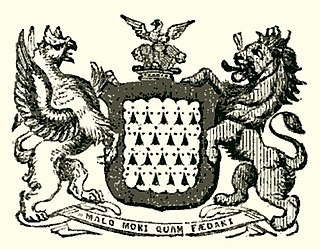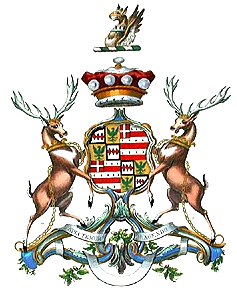Related Research Articles

Baron Trimlestown, of Trimlestown in County Meath, was a title in the Peerage of Ireland. Following the death of the 21st Baron in January 2024 with no known heir, the title is dormant, and may be extinct.

The title Baron of Dunsany or, more commonly, Lord Dunsany, is one of the oldest dignities in the Peerage of Ireland, one of just a handful of 13th- to 15th-century titles still extant, having had 21 holders, of the Plunkett name, to date. Other surviving medieval baronies include Kerry, Kingsale, Trimlestown (1469), Baron Louth, and Dunboyne.

Edward Hussey-Montagu, 1st Earl Beaulieu, KB (1721–1802), was a British politician. He was married to Isabella Montagu, Dowager Duchess of Manchester, a rich heiress.
Christopher Plunket, 2nd Earl of Fingall and 11th Baron Killeen was an Irish politician and soldier. In 1641 he negotiated with the rebels on behalf of the Old English of the Pale and pushed them to join the rebellion. He fought for the rebels at the siege of Drogheda. He joined the Confederates and fought in their Leinster army, notably at Dungan's Hill. When the Confederates fused into the Royalist Alliance, he fought under James Butler, 1st Duke of Ormond in the Battle of Rathmines where he was wounded and taken prisoner. He died of his wounds two weeks later in captivity at Dublin Castle.
County Meath was a constituency represented in the Irish House of Commons until 1800.

John Barnewall, 3rd Baron Trimleston, was an Irish nobleman, judge and politician. He was the eldest son of Christopher Barnewall, 2nd Baron Trimlestown and his wife Elizabeth Plunket, daughter of Sir Thomas Fitz-Christopher Plunket of Rathmore, Lord Chief Justice of the King's Bench in Ireland and his second wife Marian Cruise. He succeeded his father as 3rd Baron in about 1513. His father, like most of the Anglo-Irish aristocracy, had supported the claim of the pretender Lambert Simnel to the English throne in 1487. After the failure of Simnel's rebellion, he received a royal pardon.
Sir William Welles was an English-born statesman and judge in fifteenth-century Ireland, who held the office of Lord Chancellor of Ireland. He was the younger brother of Lionel de Welles, 6th Baron Welles. Lionel was a prominent supporter of the House of Lancaster, who was killed at the Battle of Towton on 29 March 1461.
Sir Christopher Barnewall (1522–1575) was a leading Anglo-Irish statesman of the Pale in the 1560s and 1570s. He was the effective Leader of the Opposition in the Irish House of Commons in the Parliament of 1568–71. He is remembered for building Turvey House, where he sheltered the future Catholic martyr Edmund Campion, for his impressive tomb in Lusk Church, and for the eulogy to him in Holinshed's Chronicles, which was written by his son-in-law Richard Stanyhurst.
Sir John Cornwalsh, or Cornwalysch was an Irish judge who held the office of Chief Baron of the Irish Exchequer. His tenure was notable for the fact that he succeeded his father as Chief Baron, and for his long struggle to retain the office in defiance of a rival claimant, Michael Gryffin. He is also remembered as the builder of Dardistown Castle in County Meath.
Christopher Bernevall, or Barnewall (1370–1446) was an Irish politician and judge of the fifteenth century, who held the offices of Vice-Treasurer of Ireland and Lord Chief Justice of Ireland. He was deeply involved in the political controversies of his time, and was a leading opponent of the powerful Anglo-Irish magnate James Butler, 4th Earl of Ormond. His elder son Nicholas also held office as Lord Chief Justice, and his younger son Robert was created the first Baron Trimleston.
The Barony of Navan was an Irish feudal barony which was held by the de Angulo family, whose name became Nangle. It was a customary title: in other words, the holder of the title was always referred to as a Baron, and this privilege was in practice hereditary, but the Baron was not a peer in the strict sense, and was not entitled to a seat in the Irish House of Lords.
The Brotherhood of Saint George was a short-lived military guild, which was founded in Dublin in 1474 for the defence of the English-held territory of the Pale. For a short time, it was the only standing army maintained by the English Crown in Ireland. It was suppressed by King Henry VII in 1494, due to his suspicions about the Brotherhood's loyalty to his dynasty. It was not an order of knighthood, although some of its individual members were knights.

John Plunkett, 3rd Baron of Dunsany was an Irish nobleman.
Sir Thomas Fitz-Christopher Plunket (c.1407–1471) was a leading Irish lawyer and judge of the fifteenth century who held office as Lord Chief Justice of Ireland. He was an ancestor of the Duke of Wellington in the female line. His second marriage to the heiress Marian Cruise inspired the ballad The Song of Mary Cruys.
James Dillon, 1st Earl of Roscommon fought for the crown in the Nine Years' War. He was ennobled despite being a Catholic after his son Robert turned Protestant.
Thomas Bathe, 1st Baron Louth was an Irish peer, barrister and judge of the fifteenth century. Even by the standards of that turbulent age, he had a troubled and violent career. He was deprived of his estates and outlawed by Act of Parliament, but was later restored to favour. His claim to the title Baron Louth was eventually recognised by the English Crown, and he ended his career as Chief Baron of the Irish Exchequer.
Baron Ratoath was a short-lived title in the Peerage of Ireland. It was created in 1468 for Sir Robert Bold, who died without male heirs in 1479.
Christopher Plunkett, 6th Baron of Dunsany was an Irish nobleman.
Nicholas de Netterville was a Crown official and judge in Ireland in the late thirteenth and early fourteenth centuries. He was the first notable member of a prominent landowning family in County Meath, who were based mainly at Dowth. His descendants in the seventeenth century acquired the title Viscount Netterville. The family also produced at least two more senior judges in the sixteenth century, Thomas Netterville and Luke Netterville.
References
- ↑ Otway-Ruthven, A.J. History of Medieval Ireland Barnes and Noble reissue New York 1993 p.120
- ↑ Patent Roll 48 Edward III
- ↑ Smith, Brendan Crisis and Survival in Late Medieval Ireland- the English of Ireland and their Neighbours 1330-1440 Oxford University Press 2013
- ↑ Otway-Ruthven p.299
- 1 2 3 4 Patent Roll 9 Henry V
- ↑ Patent Roll 8 Henry IV 4 March 1407
- ↑ Patent Roll 11 Henry IV
- ↑ Public Record Office Dublin D. 19,720
- ↑ Lodge, John and Archdall, Mervyn Peerage of Ireland Dublin 1789 Vol.6 p.165
- ↑ Cockburne v Stafford Hussey called Baron of Galtrim (1775) "Reports of select cases argued and determined in the High Court of Chancery in Ireland"
- ↑ Annual Register for the Year 1834 Hansard London 1835